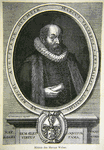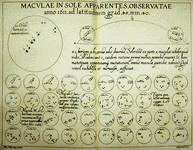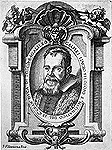Both Born on July 25: Sunspot Letters Controversy
Notes compiled by Peter Y. Chou
 |
 |
 |
| Marc Welser | Tres Epistolae by Christoph Scheiner | Galileo by Villamena |
|
While compiling a list of people born on July 25 in honor of Professor John Freccero's birthday on this date, I came across Paolo Gualdo's birthday on July 25, 1553 in the glossary of Stillman's Galileo at Work: His Scientific Biography. I typed this birthday above that of Christoph Scheiner, German astronomer, born July 25, 1575, unaware of their connection to Galileo. Later while reading James Reston Jr.'s Galileo: A Life, it occurred to me that "Apelles" whom Gualdo mentioned to Galileo in his letter of 1611 was none other than Father Christoph Scheiner. That both friend and foe of Galileo had the same birthday was a great fascination. I've included the passages from my readings on these two men.
Paolo Gualdo was born at Vicenza, Italy on July 25, 1553. He earned the doctorate in civil and canon law in 1581 after entering the priesthood in 1579. After some time at Rome he settled in Padua in 1591, where in 1609 he was made archpriest of the Cathedral of San Antonio. He died at Padua on October 16, 1621. (p. 451) Paolo Gualdo, Lorenzo Pignoria, and Antonio Querengo were among the distinguished men of letters outside the university who became friends of Galileo at Pinelli's home, a mecca for intellectuals at Padua. (p. 47) Paolo Gualdo wrote late in 1611 to say that Lorenzo Pignoria had heard from Mark Welser that in Germany, too, observations of sunspots had begun, after which two of Gualdo's friends at Padua had seen spots near the sun's center resembling eyes and a nose. (p. 180) Because a conjunction of Venus with the sun had been forecast for 11 December 1611, "Apelles" had looked for a large apparent spot on 12 December. Finding none, he concluded that either Venus was too bright with light of its own to be seen against the sun, or that it had passed not in front of the sun but behind it. In the latter case Venus must revolve around the sun, not around the earth. Galileo replied at length to Welser rejecting Apelles' conclusions. Dated 4 May 1612, this was to become the first of Galileo's three "Sunspot Letters" published in 1613 under the auspices of the Lincean Academy at Rome. (p. 182) On 8 June 1612, Paolo Gualdo wrote from Padua to say that Sagredo had sent him Galileo's letter on sunspots, which he had shown to many of his friends. (p. 184) Galileo asked Paolo Gualdo and Martino Sandelli at Padua to make a Latin translation of his book "Sunspot Letters" with a view to its publication by Cesi. [16, June 1612] (p. 187)
— Stillman Drake, Galileo at Work: His Scientific Biography
A year after Letters on the Sunspots was published, the identity of the
mysterious Apelles was revealed. He was
Father Christoph Scheiner, a Jesuit
professor of mathematics in the Bavarian town of Ingolstadt.
With the unmasking of Apelles, it became clear why the Collegio Roman had
debated the sunspot issue so heatedly, why it had tilted toward an anti-Galileo
position, and why the church censors had given Prince Cesi such a difficult time
in granting their formal imprimatur. Moreover, Father Scheiner was not backing
down from his claim of first discovery. He meant to fight, and Galileo did not
intimidate him. Thus, in 1614, Galileo found himself in an unresoved dispute
over priority with a mean and determined Jesuit. The fight was to grow meaner
in subsequent years. It would play a major role in Galileo's Inquisitional trial
eighteen years later.
As ever, Galileo would feel himself to be the aggrieved party. Eight years later,
he would write in The Assayer:
How many men attacked my letters on Sunspots, and under what disguises! The book
should have opened the mind's eye for admirable speculation. Instead it met with
scorn and derision. Many people disbelieved it or failed to appreciate it. Others,
not wanting to agree with my ideas, advanced ridiculous and impossible opinions
against me. And some, overwhelmed and convinced by my arguments, attempted to rob
me of that Glory which was mine, pretending not to have seen my writings and trying
to represent themselves as the original discoverers of these impressive marvels.
Father Scheiner would consider that a personal insult, and his passion for revenge
would smolder for twenty years.
— James Reston, Jr., Galileo: A Life, HarperCollins, NY, 1994, pp. 130-132
Late in 1612, a German Jesuit, Christopher Scheiner, wrote a series of letters to a
distinguished amateur of science, Mark Welser of Augsburg, describing sunspots and
setting forth the erroneous theory that they were tiny planets revolving erratically
about the sun. Welser published these letters, concealing the author's name under the
pseudonym Apelles, and sent them to Galileo for his comment. Galileo replied in three
letters, published in 1613 under the auspices of the Lincean Academy. He stated that
he had observed sunspots sometime before, and had shown them to friends while at Rome
in 1611, but hesitated to come forth with a theory concerning them until he was sure
of his ground. It was his opinion, however, that they were generated and dissolved on
the very surface of the sun, which rotated on its axis in approximately a month. These
views were stoutly opposed by the Aristotelans, who held the heavens to be perfect and
not subject to generation and decay. Galileo, on the other hand, saw in the sunspots
and the lunar mountains conclusive evidence for holding that heavenly bodies were of
material similar to that of the earth, and moreover he declared himself unequivocally
in his Letters on Sunspots to favor the Copernican theory.
Galileo's The Dialogue concening the two chief world systems was published at
Florence in March, 1632, and was widely acclaimed. At Rome, however, Galileo's foes
busied themselves to secure the Pope's displeasure with the book. Among these the leader
was unquestionably Christopher Scheiner, who was now still further incensed against
Galileo over a lengthy discussion of sunspots in the Dialogue, in which Galileo
not only again asserted the priority of his observations, but gave a long and reasoned
argument for the motion of the earth based upon the seasonal variations in sunspot paths.
Scheiner was convinced that Galileo had learned of those variations from a book he had
published in 1630, with the title Rosa ursina, though in fact Galileo's Dialogue
was almost through the press before he ever saw a copy of Scheiner's book, in addition to
which he could scarcely have introduced important new material after the securing of the
imprimatur. At any rate, Scheiner and his friends were successful in getting Galileo
into serious trouble, for a search of the Inquistion records disclosed an unsigned memorandum
to the effect that Galileo had been ordered not to teach Copernicanism in any way, orally or
in writing. When this was found, the Pope felt that he had been tricked into the granting
of permission for Galileo to discuss this topic, and then into permitting the licensing of
the book. Accordingly, he ordered Galileo to come to Rome to be tried by the Inquisition.
— Stillman Drake, "Galileo: A biographical sketch", in Galileo: Man of Science |
| Top of Page
| July 25
| Dates
| A-Z Portals
| News
| Quotes
| References
| Wisdom Portal Home |
© Peter Y. Chou, WisdomPortal.com
P.O. Box 390707, Mountain View, CA 94039
email address: peter@wisdomportal.com
![]()